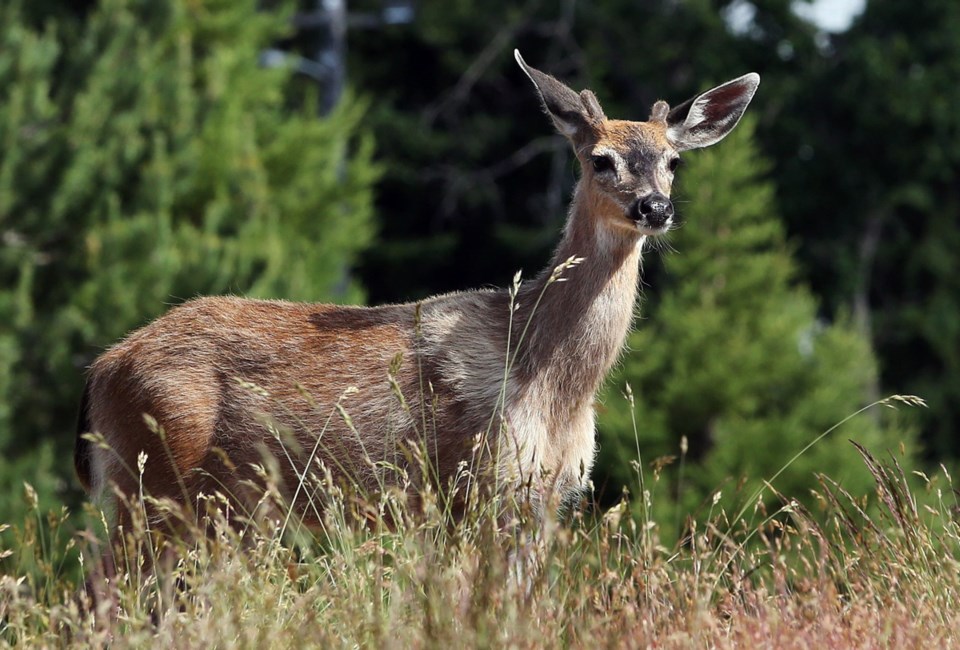Oak Bay has received its permit to cull 25 deer, but Mayor Nils Jensen is keeping tight-lipped about the details.
“We’re not disclosing when it’s going to begin or where it’s going to begin,” said Jensen, adding that receipt of the permit from the province is “just another step in the process.”
“Staff will, if they haven’t already, initiate a contract with the person who has been identified as doing this. They’ll ensure that that person has been trained and qualified in the use of the modified clover traps and ensure that the clover traps are available from the province.”
He did not know how long those steps would take.
“Part of this whole pilot project is kind of a learning process. No one on the Island has been through this in a community such as we’re doing, so we don’t know how long these steps take. Certainly, obtaining the permit [took] a little bit longer than we had anticipated, but we’re at a stage now that once these other steps are in place, we can proceed,” Jensen said.
Kelly Carson, of DeerSafe Victoria, was not surprised by the issuance of the permit. But she said the secrecy surrounding the cull is very telling.
“If this was a perfectly legitimate undertaking, they wouldn’t be sneaking around in the dark and trying to keep people out of it,” Carson said.
Provincial officials say traps are set in secluded locations to reduce stress on the deer. To further reduce stress, deer are not trapped during daylight.
Oak Bay’s controversial deer management program came about in response to complaints from residents that deer were destroying gardens and shrubs, and posing a danger to people and pets. But it has been highly divisive, pitting neighbour against neighbour.
DeerSafe, which believes the cull to be inhumane, has promised to make videos of the cull and have sent out some 5,600 notices to Oak Bay and area households urging people to notify them at the first sign of any of the clover traps being erected.
“We’re hoping for phone calls and we’ll go down and stand on their property — we don’t intend to go onto the trap property — and film it. We’ll just observe what’s happening to these animals since no one’s being straightforward about it,” Carson said.
“For the time being, the ministry and the mayor are saying that this is perfectly humane and it’s the best thing they can do to urban deer. People are pretty much buying that, I think, thinking that these are experts who know what they are talking about.
“But I think we’re going to be in a position where we can talk about it, having actually seen it.”
Oak Bay’s deer program is being done in conjunction with a $150,000 Capital Regional District deer management pilot project. Before a permit was issued, the district had to undertake a conflict-reduction program, deer-vehicle collision mitigation, public education plans and a deer count, all of which have been completed.
But critics say the municipality’s deer count was unscientific and mitigation efforts insufficient, and that the eventual cull of 25 deer is not expected to have any meaningful impact. Many advocate more measures such as public education, improved fencing, speed-limit reductions and improved signage along with use of a contraceptive vaccine to control deer numbers.
Jensen said he’s satisfied that there is no other humane way to address the issue of overpopulation. That was reinforced at a recent Ministry of Forest, Lands and Natural Resources Operations workshop, he said.
“Ministry officials made it clear that no permit has been issued or will be issued for relocation. The contraceptive immunization was reviewed and, again, it was clear that the serum is not available and, in any event, if it was, it’s an experimental drug that would need permission from Health Canada and from the province to go ahead,” Jensen said.
“And it couldn’t be used in a program. It could only be used for research purposes. We’re conducting a program. We’re not conducting a research experiment.”
Rules for thinning herd
Deer cull facts, according to a B.C. government document called Urban Deer Management in B.C.:
• As part of their deer management plans, communities must make full use of healthy deer carcasses resulting from these culls, for example by donating the meat to First Nations, local food banks or other charitable groups.
• Wildlife experts advise that capturing deer in modified collapsible clover traps and euthanizing them with a bolt gun is the safest, most efficient and most humane method of deer control in urban areas.
• Modified clover traps, which resemble oversized hockey nets, are placed in secluded locations to reduce stress on deer. To further reduce stress, deer are not trapped during daylight.
• Culls are conducted by trained contractors and meat must be processed by a qualified butcher. Organizations accepting wild game meat may distribute it to the public but may not sell it.



